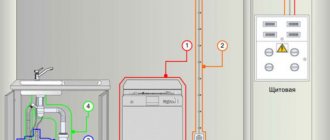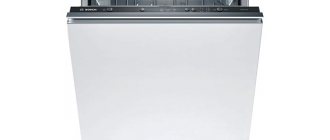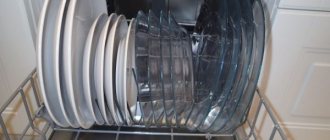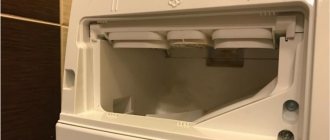The dishwasher saves not only the user’s personal time, but also water. Considering the current cost of the resource, we must recognize the feasibility of using this kitchen appliance, because... it uses very little water compared to manual washing.
- What is the water consumption of a dishwasher?
- How savings are achieved
- Comparison with hand washing
- Calculation of savings in money
- Expert advice
- Dishwasher catalog with reviews
What is the water consumption of a dishwasher?
The range of dishwashers presented by different manufacturers includes narrow, compact and full-size options that differ, among other characteristics, in chamber capacity. We can say that water consumption depends on this indicator.
For 60 cm
Full-size dishwashers can clean 10 to 14 sets of dishes in one cycle and use 9-14 liters of water. Some expensive full-size PMMs consume only 6.5-7 liters, depending on technical capabilities.
A small family should not purchase a machine with a large chamber, so as not to waste excess water. Having dirty dishes pile up for days is not very pleasant, and it can also lead to a bad smell in your car.
hio 3c23 wf
For 45 cm
As a rule, water consumption in narrow PMM models of different brands is small - up to 9 liters per working cycle. This technique can accommodate up to 9 sets of dishes and consumes 0.69 kWh during the normal program, which lasts an average of 205 minutes.
Compact PMM
The washing chamber of compact dishwashers can accommodate 6-8 sets of dishes. At the same time, the machines consume the same amount of water as narrow or full-size economical versions - 6.5-9 liters. It turns out that the same amount of resources is consumed, and less dishes are washed.
But still, consumption depends to a greater extent on such design characteristics as efficiency than on dimensions and capacity. The more efficiently a technology saves resources, the higher its cost.
4 SKS62E88
By mode
Water consumption during machine washing depends on the selected program. The half-load mode allows you to reduce water costs by 20-30%.
The function of intelligent load assessment, provided in the premium PMM, is that the device automatically determines the required volume of water depending on the amount and degree of soiling of the dishes.
Manufacturers equip their equipment with different programs and options, but water is consumed approximately as follows:
- “Light pollution” will require 7 liters.
- In “Economic” mode, 8-9 liters will be spent.
- The “Auto” option assumes consumption of 6-11 liters.
- With “Intensive” washing, resource costs will increase to 10-11 liters.
Have you set the water hardness in PMM?
Yes, of course. No.
By brand
Each manufacturer produces PMMs with different characteristics, but in general all companies strive to minimize water costs using innovative solutions. If we summarize the performance of dishwashers of different brands, the average water consumption of the appliance can be represented as follows:
- Bosch - about 10 l;
- Siemens – 7 l;
- Candy – 8-13 l;
- Beko – up to 12 l;
- Electrolux – up to 10 l;
- Indesit – 7 l.
- Ariston - 8-10 l.
hsie 2b19
What does consumption depend on?
The cost-effectiveness of technology depends on the manufacturer - its scientific and technical capabilities, which allow the creation of progressive and knowledge-intensive modifications. Depending on the level of liquid consumption, dishwashers are distinguished:
- highly economical;
- moderately economical;
- uneconomical.
Also, PMMs are divided into classes based on efficiency - from A to G. Popular brands - Bosch, Candy, Electrolux and others, produce only highly economical models of classes A - C. Uneconomical versions are no longer produced in Europe, and their import is prohibited.
How much liquid the device takes per cycle is an indicator not regulated by standards. The water consumption class is affected by:
- design solutions used in a specific modification;
- availability of additional functions.
All modifications can be divided into 3 groups:
- Household appliances are full-size and narrow. They spend 9–14 liters.
- Compact - 6.5–10 l.
- Large devices. The consumption of professional dishwashers installed in catering outlets is 20–25 liters.
How savings are achieved
The dishwasher uses water more economically thanks to the following operating features:
- The water in the device is reused many times, purified using filters.
- Water is sprayed under high pressure.
Water in the PMM is used at three stages:
- pre-spraying;
- main washing cycle;
- rinsing.
After completing the first operation, the machine does not drain the water into the sewer, but passes it through a filtration system and reuses it. After washing dirty dishes, the equipment partially drains the liquid and adds a fresh portion from the water supply to the remainder.
Expert opinion
I work in the household appliance repair industry. Extensive experience in restoring washing machines and dishwashers.
Ask a Question
Thanks to the high flow rate of water from the sprinklers, the quality of washing dishes is improved and the process is accelerated, as well as resource consumption is reduced.
Advantages and disadvantages
In addition to saving water, dishwashers have many other advantages, but there are also disadvantages. Let's look at them.
Advantages
When washing dishes in the dishwasher, the water temperature often reaches +75…90 ℃. Thanks to this, the sterility of kitchen utensils is achieved, which will especially appeal to mothers with small children, for example.
In addition, the quality of washing dishes in a dishwasher is many times higher than by hand. This depends not only on special detergents, but also on the very high temperature of the water in the dishwasher. In addition, it has been proven many times that dishwashers save their owners time over the course of a year, which can be compared to a person’s labor for a month.
Washing dishes by hand wastes much more water than using a machine.
You should know that a dishwasher can be used to wash more than just dishes. Gas burners from stoves, barbecue grills, baking dishes and much more can also be easily washed with its help without wasting your time and effort.
Flaws
When making a choice in favor of one model or another, be sure to think about how many dishes you expect to use per load. By purchasing a full-size model for a small number of people, you risk turning your new kitchen assistant into a warehouse for unwashed dishes, which will also smell bad.
Don't turn your appliances into storage for unwashed dishes
Sometimes the dishwasher will have to be cleaned and washed. You will need to run idle cycles periodically to perform the self-cleaning process. You will also need to clean the pump and filters occasionally.
Those who previously considered a dishwasher a luxury item sooner or later change their minds, especially when they see lower numbers on the meter and lower water service charges. Of course, a dishwasher will help save money, time and effort for the whole family.
Comparison with hand washing
In addition to the fact that the dishwasher uses water repeatedly and therefore consumes a small volume, the device only draws cold water for its operation, heating it to the desired temperature. This solution is cheaper for the user.
Even if you take into account the energy consumption for heating, this method will still be cheaper than using hot water. In addition, hot water from the tap is dirtier; its impurities can quickly clog PMM filters.
Practice shows that when washing the same volume of dirty dishes, a machine consumes 10 times less water than the housewife using the manual method. At the same time, self-washing involves the use of more expensive hot water.
Is a dishwasher profitable?
Oh yes! No
When washing dishes by hand, up to 100 liters of mixed water goes down the drain. The appliance will clean the same number of kitchen utensils, spending approximately 10 liters. Consumption depends on the model and selected mode.
Experts believe that a dishwasher pays for itself within 4 years on average. Household appliances stores regularly hold promotions and make attractive offers to customers.
Where do the savings come from?
Many consumers are interested in whether a dishwasher saves water? How is it that a machine uses less fluid than a person? It's all about the principle of operation of the device:
- The liquid that the machine washes dishes with is reused many times. It does not go down the drain, as with hand washing, but is cleaned again and again, passing through the filter device.
- Liquid spraying occurs under strong pressure. Passing at high speed through the sprayer, it thoroughly and efficiently washes the dishes. Thanks to this technology, about 10 liters of liquid are consumed per wash, and the dishes are spotlessly clean, shiny and even squeaky.
Calculation of savings in money
The annual water consumption for washing dishes is as follows:
- in the car - 10 l * 365 days = 3650 l of cold water;
- manually – 100 l * 365 days = 36500 l of mixed water.
Let's assume that the cost of a cubic meter of resource in the user's region is:
- cold water supply – 20 rub./m³;
- hot water supply – 70 rub./m³.
Let's calculate the annual water consumption in monetary terms:
- PMM – 3,650 m³ * 20 rub./m³ = 73 rub.
- Manual washing – 36,500 m³ * 70 RUR/m³ = 2555 RUR.
Obviously, using kitchen appliances brings big savings. This calculation does not take into account the difference in the cost of detergents: tablets, rinse aid and special salt for water softening.
Volumes and principle of saving a dishwasher
The principle of saving is based on the repeated use of the same water, which passes through the purification filter several times.
An additional set is usually done only 2 times for preliminary and final rinsing. In this case, the jet is supplied under pressure in the form of highly atomized droplets. A similar principle is sometimes used in the design of economical shower heads and, to a lesser extent, in some modified aerators (for example, https://water-save.com/). To determine whether a dishwasher saves water, it is enough to compare the minimum water consumption when washing dishes by hand in running water with the maximum water consumption of the most uneconomical “dishwasher” after dinner for 7 people. This set for seven includes: 7 plates, cups, forks and spoons, 1 saucepan, 3 bowls for salads and preserves, cutting board, teapot.
- Calculation data.
Water consumption for manual washing (based on SNiP standards) differs for different plumbing fixtures and varies in the range of 0.12-0.25 l/sec for household appliances, which corresponds to 7.2-15 l/min.With a minimum volume and high calculated rates, 1 set = 0.5 minutes (that is, 7 sets = 3.5 minutes) gives an approximate volume of 25.2 liters. For comparison: the most uneconomical domestic models “spend” 25-26 liters per cycle.
- Experimental data.
The average water consumption model Siemens SN 66M094 with a stated 10 liters per cycle was loaded with 14 sets of dishes, which it washed in intensive mode. After that, 7 more sets were washed by hand, and every time another item was soaped, the tap was turned off. The beginning and end of the process were marked on the counters. As a result, the entire wash took 20 minutes, during which 23 liters flowed out of the “hot” tap and 20 liters from the “cold” tap. The difference, even under these unequal conditions, was 33 liters.
Some experts draw attention to the fact that real machine “waste” is 1-2 liters more than stated. However, taking this error into account, the amount of water consumed differs several times in favor of automation. At the same time, the advantages of automatic units include the fact that they:
- most often connected to cold water supply, that is, they consume cold water, heating it during operation,
- raise the temperature to 55-70 degrees, which is higher than the temperature that a person sets for himself, and thanks to this it is easier to cope with grease and dried dirt,
- avoid contact of hand skin with detergents,
- softens hard water.
However, for a full financial assessment of the efficiency of a dishwasher, the consumption of water, electricity and relatively expensive detergents on the scale of annual consumption is taken into account:
- Saving direct water resources does not raise any doubts and is estimated, on average, at 7500-8500 l/year for units of the middle efficiency class. Moreover, this number can be increased by purchasing an economical device and wisely using various modes.
- Calculations on electricity consumption are complicated by the fact that in everyday life, before purchasing a heating unit, boilers can be used for heating, which also consume electricity, geysers or a centralized water supply system, with which energy consumption is usually compared. In addition, the difference between the highest efficiency class and the average reaches 30%.
- High requirements for “chemicals” (this also includes cleaners that are poured into the device to prevent scale formation) do not allow saving on detergents.
Based on the total amount of money spent, most often there are no noticeable financial savings when purchasing “dishwashers”.
Automation allows you to significantly optimize water consumption and the owner’s free time.
Expert advice
When choosing a dishwasher in a store, pay attention to such indicators as:
- washing class;
- Economy mode and half load option available.
The operation of class A appliances is characterized by the lowest water consumption. According to this indicator (from A to G), dishwashers are divided into:
- economical;
- average degree of efficiency;
- low-cost.
In recent years, kitchen appliance manufacturers have been producing devices that use water resources as efficiently as possible.
Special modes will help reduce the amount of water consumed:
- economical;
- for light contamination;
- half load.
Remember also that proper placement of dishes will ensure ideal washing results and make it possible to reduce water consumption. Recommendations for the distribution of kitchen utensils in the washing compartment can be found in the user manual.
There are many benefits of using a dishwasher in your home. In addition to saving time and the ability to go about their business, the user receives a reduction in water consumption. The technology uses an expensive resource efficiently and repeatedly.
Advantages of dishwashers
The general design of all models is similar: two or three baskets for dishes, various trays for cutlery. All modern models are equipped with a heating element. Thus, the presence or absence of hot water will not affect the result in any way.
This can already be considered a beneficial advantage, because the tariff for cold water is several times lower.
Dishwashers have filter elements through which the same volume of water is used several times. Achieving such a result manually is very difficult. Some models are equipped with a “half load” or “auto mode” function; the washing cycle may not change in time, but the water consumption will decrease by about a quarter.
In addition, there is another class of water consumption of cars:
- highly economical;
- medium-economical;
- low-economical.
According to standards, the class is marked with the letters A, B and C, respectively. Most models, of course, go under class “A”, but when choosing a suitable car for your home you should pay attention to this parameter.
Comparison of the effectiveness of popular models
The water consumption in a Bosch dishwasher is considered to be one of the lowest, compared to models of a comparable class. This brand represents products for all types of devices, including compact devices. Other popular brands include Electrolux, Hansa, Smeg, Siemens, NEFF, AEG, Candy. A summary table by type, water consumption, capacity and energy consumption for some models of these brands is presented below:
Read more
- Calculation of a coil for heating water
- How to save water
Review of the Bosch SMS25AW01R freestanding dishwasher
Many people are prejudiced against dishwashers. Like, they are complicated, and they launder poorly, and why spend money at all? Especially to convince skeptics, you should buy your first car with simple controls, good washing quality and an established reputation as a manufacturer.
One example of such a device is the Bosch SMS25AW01R dishwasher. We took it for testing and subjected it to our complex and rather dirty tests. We'll tell you about them, as well as why this model is easy to operate.
Characteristics
| Manufacturer | Bosch |
| Model | SMS25AW01R |
| Type | freestanding wide dishwasher |
| Country of Origin | Türkiye |
| Guarantee | 1 year |
| Life time* | 10 years |
| Capacity | 12 sets of dishes + 1 serving set |
| Energy efficiency class | A |
| Wash class | A |
| Drying class | A |
| Consumption parameters: | 10.5 l/1.05 kWh |
| Water consumption on Eco program 50 °C | 10.5 l |
| Cycle duration on Eco program 50 °C | 210 minutes |
| Noise level | 48 dB |
| Number of programs | 5 |
| Half load | There is |
| Start timer | 1-24 hours |
| Power consumption | 2400 W |
| Weight | 44.3 kg |
| Dimensions (W×H×D) | 600×845×600 mm |
| Network cable length | 1.75 m |
| Retail offers | find out the price |
* Contrary to popular belief, this is not the time limit after which the device will necessarily break down. However, after this period, the manufacturer ceases to bear any responsibility for its performance and has the right to refuse to repair it, even for a fee.
Equipment
Like most major appliances, this dishwasher is packaged in foam and cardboard, covered with plastic wrap. The sticker on the front side informs about the full model index, country of manufacture and protection class of the device.
In addition to the machine itself with two installed baskets and a drain hose, the package includes:
- inlet hose
- cutlery basket
- electrical wire
- user manual
- quick installation guide
- product certification information
- energy efficiency sticker
- trial package with the manufacturer's recommended dishwashing detergent
Our dishwasher's equipment is typical for machines of this class, but we were surprised by the absence of the usual salt funnel and drain hose support.
At first sight
The car body is white. Like most freestanding dishwashers, the control panel of the Bosch SMS25AW01R is located on the front, on the door. There is a niche handle underneath it. The front legs of the device allow you to adjust the height of the model and level it horizontally.
The side walls are smooth, without decorative stampings or other decorations. The top plastic panel can be removed if the machine is installed as a partially built-in machine - in a niche of a kitchen unit.
The corrugated drain hose is already installed on the device. The filler fitting is located at the bottom of the rear panel, closer to the right edge. The connector for connecting a removable electrical wire is located in the lower left corner.
The Bosch SMS25AW01R tank has a plastic bottom, and the walls are made of stainless steel.
The spray arms that supply water to the dishes are slightly curved: this makes it easier for the impellers to rotate. Under the lower one there is a filter block of a traditional design (a metal grid and a cylindrical fine filter made of nylon mesh) and a water softener neck through which salt is poured.
The container for household chemicals is divided into two parts. The right half is intended for bulk or tablet detergents, the left, equipped with an indicator window, is for liquid conditioner.
Both baskets on the Bosch SMS25AW01R are removable. The lower one, intended for large plates and kitchen utensils, is equipped with two rows of holders. The far row can be folded, the near one has a fixed structure.
The upper basket is for small dishes. It is equipped with removable shelves for cups with triangular slots, convenient for supporting the stems of glasses. If necessary, the shelves can be moved to the opposite side of the basket.
Under the upper basket there is another sprinkler - the same shape as the lower one. Support rollers of the container allow you to adjust the installation height: upper and lower positions are available.
The cutlery container is divided into six compartments: the outer ones are slightly smaller, and the middle ones are larger. This basket has hinged lids on both sides. Spoons, forks and table knives can be placed through their holes or placed directly in the compartments.
The inlet hose is of a simple design; it does not have an AquaStop valve: the built-in leak protection will not save you from a flood if it is damaged.
The dishwasher is connected to the electrical network using a removable cable with a rather rare type of connector.
The machine also includes a sampler with dishwashing detergent. Bosch recommends using Finish Powerball tablets in its dishwashers.
Instructions
The user manual is an A5 brochure. As often happens, the manufacturer saved on printing costs and technical writers by preparing one document for several dishwasher models at once. The user must find information about the features of his model here on his own.
The instructions provide information about the structure of the machine, operating the device, its operation and care. At the end of the brochure there are detailed technical specifications and a list of possible malfunctions with methods for eliminating them yourself.
The documentation set also contains a detailed guide to connection and installation. It contains many detailed drawings and diagrams illustrating all stages of device installation - from unpacking to first start-up.
Control
The plastic control panel is located on the front wall of the machine. On the left side there is only a button that turns the device on and off.
The right side consists of a small round program selector with a Start button on it, a digital display and two buttons, one of which controls the delay start timer, and the second activates the half-load mode.
Bosch SMS25AW01R has only five programs:
- standard
- Eco
- glass
- fast (1 hour)
- rinsing
The selector has three more fixed positions, but they are not used in this model.
Using the button with a dial image, you can set the delayed start mode: from 1 to 24 hours in one-hour increments.
The half-load mode, activated by the second button, allows you to reduce the duration of the main cycles (standard, economical and for glass) and save water and electricity.
When you select a program, the digital display shows its expected duration, and when the device is running, the time until the end of the cycle. Below the screen there are three indicators that warn the user of possible problems: problems with the water supply, lack of rinse aid and lack of salt in the softener tank.
Exploitation
If you have connected one dishwasher, then you know how to connect most - the process is standard. Bosch SMS25AW01R is no exception to this rule: the corrugated drain hose must be connected to the sewer, and the fill hose must be connected with one end to the water supply system and the other to the fitting on the rear panel. Of course, the electrical wire should also be connected to the corresponding connector.
After connecting to the communications, it is recommended to align the machine installed in a kitchen unit or a free-standing machine horizontally.
Before the first use, it is worth checking the hardness of the water in the water supply (this can be done at the water supply organization), pouring a supply of salt into the softener and setting its consumption in accordance with the obtained parameters.
If tablets are used (when testing dishwashers, according to the general methodology, we use Finish Powerball All in One Max), it is also better to set the rinse aid consumption to a minimum. But there is no need to use the dishwasher without this product.
The setup mode for this model is activated when the door is closed by turning the selector with the Start button pressed. The following settings are available to the user:
- Water hardness : eight steps from 0 to 7 (default - 4)
- Amount of rinse aid : six levels from 0 to 6 (default - 5)
- Automatic shutdown after the end of the program: do not turn off, turn off after 1 minute or after 120 minutes (default - after 1 minute)
- Intensive drying : final rinse with water at elevated temperature, which improves the quality of condensation drying (default - off)
The Bosch SMS25AW01R dishwasher offers the user the following programs:
| Program | Type of pollution | Program Execution |
| Normal 65° | strongly adhered, burnt or dried food residues containing starch or protein | Pre-rinse Wash 65° Intermediate rinse Final rinse Drying |
| Eco 50° | slightly dried ordinary table scraps | Pre-rinse Wash 50° Intermediate rinse Final rinse 65° Dry |
| Glass 40° | slightly adhered, fresh food remains | Pre-rinse Wash 40° Intermediate rinse Final rinse 60° Dry |
| Fast (1 hour) | slightly dried ordinary table scraps | Wash 65° Intermediate rinse Final rinse 70° Drying |
| Rinse | cold water rinse, intermediate wash | Pre-rinse |
The Bosch SMS25AW01R has a minimum of modes: there is no usual scenario for intensive washing, no night mode, or automatic program. Before us is one of the simplest devices in the budget Serie 2 line. Even without looking at the user manual, you can understand: the machine has “sisters” with a large number of functions - this is hinted at by the empty sectors of the program selector.
This model has two additional functions: delayed start and half-load mode, which saves energy, time and water. It would be more logical, in our opinion, not to hide the intensive drying option in the settings, but to display it on the control panel. But the manufacturer decided differently.
The SMS25AW01R does not have a floor-mounted operating indication, but for free-standing appliances this drawback is not significant: the display is not covered by the furniture façade and makes it easy to control the washing cycle.
Care
If the dishwasher is dirty, the manufacturer recommends loading a tablet or powder into the machine’s container and running the program with the highest water heating temperature.
To maintain cleanliness at all times, the door seal should be wiped regularly with a damp cloth and a small amount of detergent.
During long periods of inactivity, it is better to leave the door slightly open to avoid the formation of an unpleasant odor.
The front panel is wiped in the same way as the seal. The use of sponges with a rough surface and abrasive materials is prohibited. Also, do not use chlorine-containing products.
Our measurements
The manufacturer does not provide information about water and electricity consumption in various operating modes in the documentation. The table below shows our measurement results.
| Program | Duration | Water consumption, l | Energy consumption, kWh |
| Normal 65° | 2:15 | 12,9 | 0,978 |
| Eco 50° | 3:30 | 11,4 | 0,921 |
| Glass 40° | 1:40 | 12,5 | 0,577 |
| Fast (1 hour) | 1:00 | 10,1 | 0,940 |
| Rinse | 0:15 | 4,1 | 0,047 |
The maximum power consumption we measured was 2114 W.
The noise emitted by the device during operation does not exceed 49 dBA. The figure obtained during testing is almost no different from that indicated in the documentation.
In standby mode, the dishwasher consumes 2.6 W, and in off mode it consumes less than 0.1 W.
Practice tests
Eco mode and “artificial dirt”
Let's turn to the ideal food mud we developed - a mixture of ketchup and the cheapest industrial mayonnaise. It is so sticky and dries so well that it is honestly very difficult to wash it off. We suggest you try it yourself and see for yourself.
We placed the dishes stained by this invention in both baskets, and placed the container with cutlery in the lower container. The set for six appliances fits very comfortably inside a wide dishwasher - there is still enough space left in it.
For this test, we chose the “Eco” program and were not mistaken: in the standard economy mode, heavily soiled dishes were washed perfectly - both in the upper and lower basket.
There are no traces of mixture or greasy residue left: the surface of plates, cups and bowls is perfectly clean.
We were also pleased with the quality of drying: there was not a drop on the dishes.
Result: excellent.
Remove dried ketchup in one hour
To test the effectiveness of the quick one-hour program, we artistically decorated the inside of three glass jars (one three-liter and two two-liter) with ketchup and left them to dry for a day.
The containers were placed in the lower basket, closer to the rear edge. In this case, one of the guides had to be folded.
After that, we launched the “Fast” program and waited exactly an hour.
No traces of contamination were found on the jars, but some moisture remained inside the vessels. This is, however, normal for a program with a short drying cycle.
Result: excellent.
Wine glasses and glass program
Several thin glass glasses were heavily stained with red wine and lipstick (oily and with good long-lasting pigment). As in previous tests, we left the dishes to dry for 24 hours.
We placed the glasses, as if bearing traces of a wild party, in the upper basket - with their legs on shelves with ribbed edges. The basket fits four large (0.650 l) red wine containers perfectly.
Of course, for thin glasses we used the “Glass” program - that’s what it’s designed for.
We have yet to meet a dishwasher that fails this test. And this time it didn’t work out - the Bosch SMS25AW01R perfectly washed glasses with traces of lipstick and wine.
The drying cycle of the program was also very effective: the glasses were clean and dry.
Result: excellent.
Program for normal washing and heavily soiled dishes
For testing in the mode of washing intense stains, we, as usual, use a ceramic form in which meat was baked in sour cream sauce: this mixture is baked so well that it is extremely difficult to wash it with your hands. To enhance the effect, we kept the empty pan in the oven for another fifteen minutes and then forgot it for a day.
Of course, dishes are usually not put in the dishwasher after such abuse - they should have been soaked and at least tried to remove any remaining food. However, we have a clear goal: to test the device under extreme load and see what comes out of it.
The model does not have a special mode for intensive washing of heavily soiled dishes, so we chose the longest and hottest option offered - the “normal” program with washing at a temperature of 65 °C.
Pieces of burnt crust remained on the ceramic only at the edges, where it was originally thickest. During washing, they softened so much that all that remained was to wipe the edges with a damp sponge and rinse with water.
We have come across dishwashers that washed such stains clean and without traces, but you need to understand: in this case, a program was used for ordinary, normally soiled dishes (we remind you that this model does not have a special intensive scenario), and therefore we consider the result more than good .
Result: good.
conclusions
The Bosch SMS25AW01R dishwasher is a typical example of a budget model from the junior line: it has a minimum of programs and a minimum of additional options. This is one of the simplest and most inexpensive wide freestanding dishwashers from this manufacturer. Nevertheless, the range of scenarios and options offered by the machine is sufficient for most life situations, and the quality of washing and drying dishes from this PMM is quite good.
SMS25AW01R is suitable for those who do not want to overpay for additional options, but prefer to use equipment with a long service life, created by a world-famous manufacturer with a reputation that has developed over many decades. Even older people can master the simple operation of this machine.
pros:
- high efficiency of washing and drying
- good efficiency
- Ease of Management
- relatively low price
Minuses:
- minimalistic set of dishwashing programs and additional options











